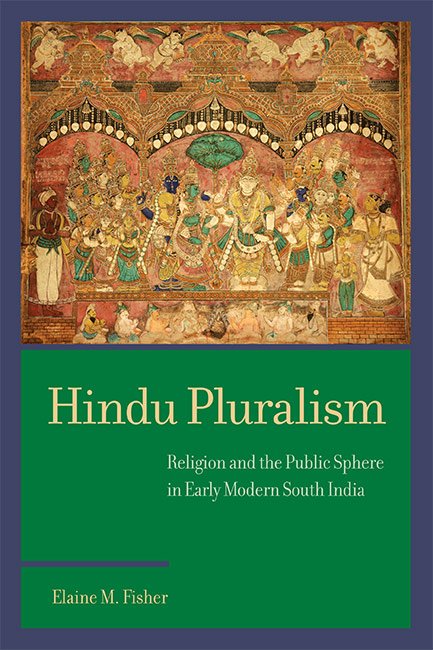Hindu Pluralism
by Elaine M. Fisher | 2017 | 113,630 words
This thesis is called Hindu Pluralism: “Religion and the Public Sphere in Early Modern South India”.—Hinduism has historically exhibited a marked tendency toward pluralism—and plurality—a trend that did not reverse in the centuries before colonialism but, rather, accelerated through the development of precolonial Indic early modernity. Hindu plur...
_NOTES
{START:1:}
1. Luhmann (1995, 17) anticipates such a circumstance, in which shared resources come to play a role in constituting a distinct system: “The concept of boundaries means, however, that processes which cross boundaries (e.g., the exchange of energy or information) have different conditions for their continuance (e.g., different conditions of utilization or of consensus) after they cross the boundaries.”
{END:1:} {START:2:}
2. Haradatta, author of the Śrutisūktimālā, also known as the Caturvedatātparyasaṅgraha, is cited as early as Śripati’s Śrīkarabhāṣya, a Vīraśaiva (Śaktiviśiṣṭādvaita) commentary on the Brahmasūtras (circa thirteenth or fourteenth century), and Umāpati’s commentary on the Pauṣkara (circa fourteenth century).
{END:2:} {START:3:}
3. mlecchācāraparāḥ sarve daridrāś ca dvijātayaḥ | bhaviṣyanty alpamatayaḥ yatis tatra bhaviṣyati || śive madaṃśasaṃbhūtaḥ śaṅkaraḥ śāṅkarottamaḥ | caturbhiḥ saha śiṣyais tu kalāv avatariṣyati || tasmai copaniṣadvidyā mayā dattā maheśvari | bhūmau pāṣaṇḍaṣaṇḍānāṃ khaṇḍanaṃ sa kariṣyati || kalāv eva mahādevi haradattābhidho dvijaḥ | aśaivadaṇḍanārthāya bhaviṣyati mahītale || dīkṣito ‘pi bhaved kaścin madaṃśo bhūsuro ‘mbike | bhāsurācāranirataḥ śaivacchandogavaṃśajaḥ || anye ‘pi bhaktā deveśi cere cole ca pāṇḍyake | bhaviṣyanti mahābhaktā mayi sarvāsu jātiṣu || sundaro jñānasambandhas tathā māṇikyavācakaḥ |
{END:3:} {START:4:}
4. The term aṃśāvatāra typically implies not that the individual is only partially a divine incarnation, but rather that he or she is a full incarnation of a portion of the god in question.
{END:4:} {START:5:}
5. Ramanathan (1966). These newsletters published short essays in Sanskrit, English, Tamil, Telugu, and Hindi celebrating the remembered life of Appayya Dīkṣita, both historical and hagiographical, and advertising the publication ventures of many of his previously unpublished works.
{END:5:} {START:6:}
6. This Sivananda is not to be confused with the nineteenth-century biographer of Appayya of the same name, author of the Appayyadīkṣitendravijaya, although both are descendants of the Dīkṣita family. Swami Sivananda, in fact, was born in Palamadai, Nīlakaṇṭha’s ancestral agrahāra.
{END:6:} {START:7:}
7. Shulman (2014).
{END:7:} {START:8:}
8. Mūkakavi, known only by the name “the Mute Poet,” is reputed by legend to have been deaf and dumb until granted the blessings of the goddess Kāmākṣī, at which point he spontaneously burst into poetry, composing the Mūkapañcaśatī. Unsurprisingly, the very same narratives about his divine gift of poetic virtuosity are often applied in south Indian Smārta circles of Kālidāsa as well (see chapter 2 for further discussion). As for his historical origins, the editor of the Mūkapañcaśatī (Kāvyamālā, vol. 5), writes, “It is not certain when this poet, originating in the Drāviḍa country, was born, but it appears that he was not very ancient.” His verses are scattered with Śrīvidyā terminology and specific references to the deities of Kanchipuram; in short, he could not possibly have lived earlier than the seventeenth century, as his writings evoke a full-fledged south Indian Smārta-Śaiva religiosity. I have seen no evidence that Nīlakaṇṭha or any other scholars of his generation were aware of his existence.
{END:8:} {START:9:}
9. idaṃ hi paraśivenādināthena prathamam upadiṣṭaṃ śrīdevyai. akhilapuruṣārthaikaghaṭanāsvatantre ‘smiṃs tantre sudṛḍhe pakṣapāta āviṣkṛtaḥ śrīśaṅkarācāryabhagavatpādair mantraśāstrasarvasvabhūtāṃ saundaryalaharīṃ lalitātriśatībhāṣyaṃ ca praṇītavadbhiḥ. vaidikaśikhāmaṇayo mahākavayaḥ prācīnāḥ kālidāsamūkādyā arvācīnā nīlakaṇṭhadīkṣitādayaś ca devīcaraṇāmbujadvandve dṛḍhaṃ baddhabhāvā iti ghaṇṭāghoṣo jegīyatetarām. vidyāraṇyaprabhṛtayo ‘dvaitavidyādeśikavaryā api vidyāṃ samupāsāṃcakrira iti nirdhārito ‘yaṃ viṣayaḥ. vidyāraṇyamunibhir vidyārṇavākhyo mahāmantraśāstragrantho vyaracīti, tathaiva śrīmadappayyadīkṣitaiḥ parimalābhidhāno mantraśāstragranthaḥ praṇāyīti ca karṇākarṇikayā śrūyate. paraṃ tu granthāv imau sākṣān na dṛṣṭacarau. ādiśaṅkarabhagatpādopakramam avicchinnapāramparyeṇa tatra tatra śāṅkaramaṭheṣv ācaryamāṇā śrīcakrapūjā ca pañcadaśākṣarīvidyāsampradāyavaidikatvaṃ niḥsandigdhaṃ pratiṣṭhāpayati. paraḥsahasrair hi śrutismṛtisampradāyapravarair ārādhyate kāñcīmaṇḍalaṃ maṇḍayantī kāmākṣyabhidhānā rājarājeśvarī yaiva paradevatā śrīvidyā, tathā madhurāpurīṃ vidyotayantī mīnākṣī yā śrīvidyāyāṃ mantriṇīti prathitā, tathā jambukeśvarakṣetraṃ bhāsayantī akhilāṇḍeśvaryāhvayā devī yā kila mantraśāstre daṇḍinī daṇḍanāthetyādīn vyapadeśān bhajate, tathaiva kanyākumārīkṣetraṃ prakāśayantī śrīkanyākumārī ya hi śrīvidyāyāṃ tryakṣarī bāleti prathitābhidhānā. śrautasmārtakarmānuṣṭhānatatparā dvijāḥ sarve ‘pi pratyahaṃ samupāsate sāvitrīṃ vedamātaram. ata eva ‘antaḥśāktā bahiḥśaivā bhuvi sarve dvijātayaḥ’ iti vādo ‘pi saṃgacchate. tena śrīvidyāsaṃpradāya eva smārtasaṃpradāya iti suśliṣṭam. Sastri, Śrīvidyāsaparyāpaddhati, 1938, pg. 3.
{END:9:} {START:10:}
10. Personal communication with various descendants of Nīlakaṇṭha, January 2011.
{END:10:} {START:11:}
11. “Follow Vivekananda’s Message to Avert Attacks Like 9/11: PM Narendra Modi,” Hindustan Times, September 11, 2014, www.hindustantimes.com/india-news/follow- vivekanandas-message-to-avoid-attacks-like-9–11-modi/article1–1262751.aspx.
{END:11:} {START:12:}
12. Vivekananda, The Complete Works of Swami Vivekananda, 1970, 2.
{END:12:} {START:13:}
13. Śivamahimnaḥ Stotram, v. 7: trayī sāṃkhyaṃ yogaḥ paśupatimataṃ vaiṣṇavam iti prabhinne prasthāne param idam adaḥ pathyam iti ca | rucīnāṃ vaicitryād ṛjukuṭilanānāpathajuṣāṃ nṛṇām eko gamyas tvam asi payasām arṇava iva ||
{END:13:} {START:14:}
14. Halbfass (1988, 411), quoting Hacker (1978).
{END:14:} {START:15:}
15. On the Indian case, see most notably Bilgrami (2014).
{END:15:} {START:16:}
16. See for instance Thomas (2014) and Schonthal (2012).
{END:16:} {START:17:}
17. Doniger and Nussbaum (2015, 16).
{END:17:} {START:18:}
18. Doniger (2009, 533).
{END:18:} {START:19:}
19. See for instance Hawley (2015);Richardson (2014); Horstmann (1999); Case (1996).
{END:19:} {START:20:}
20. Nussbaum, The Clash Within, 2007, 8.
{END:20:}
